#is a two-year online learning program from JTS
Explore tagged Tumblr posts
Text
what can I doooooooo with my liiiife!?
(I didn’t get the job at the Jewish day school and I still can’t afford graduate school and I can’t travel because of my masking)
#I think the most reasonable but still expensive thing I’ve found so far#is a two-year online learning program from JTS
5 notes
·
View notes
Text
April 17, 2020

Photo: Chickens in the barnyard.
At North Country School the belief that nature is our master teacher is woven into all that we do. It is the thread that connects us to the majestic wild spaces that surround our 220-acre campus, to the seeds we sow each spring that become our food, and to the barnyard creatures that we care for together on our farm. The children who attend North Country School and Camp Treetops form a deep understanding of the life cycles of our natural world, and the lessons learned through that understanding are carried with them their entire lives. Observing the cycles of the natural world—the changing of the seasons, the sprouting of a seed, the growth of a seedling, the laying and hatching of an egg—can bring calm, appreciation, and reflection to our current lives where those peaceful moments may be in shorter supply. During a time when much of our community is scattered around the globe, we take solace in the fact that our current and past students and campers bring that connection to nature with them. We hope that, wherever you are, you can take a moment with your loved ones to observe and enjoy the outdoors. Know that we on the North Country School campus will be doing the same.
Please keep sending us your photos, and we will add them to our NCS at Home: Spring 2020 photo library. Email photos to [email protected].
Note: Our campus is closed to all students for the remainder of the school year, with the exception of the international students who remained here during spring break, rather than returning to their home countries during the early stages of the outbreak. These 18 students, along with our houseparents and faculty, are staying on campus and enjoying outdoor adventures in the contiguous wilderness during this time. They have been and will continue to take appropriate safety and prevention measures.
CREATIVITY AND CONNECTION

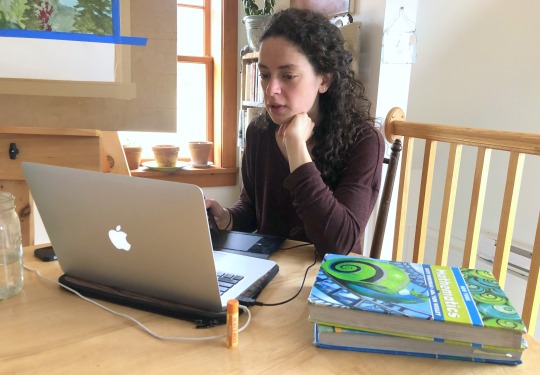

Top: Jack teaches 6th-grade English class. Middle: Gavi teaches 4th- and 5th-grade math class. Bottom: Gavi’s math lesson.
This week our teachers, like so many educators around the globe, continued to think of new and creative ways to engage with students. 6th-grade humanities teacher Jack introduced his class to a fun vocabulary game using the educational website Quizzizz, while 4th- and 5th-grade math teacher Gavi taught her class a fractions lesson using a tablet as a whiteboard, which allowed her to work through equations alongside the class in real-time.
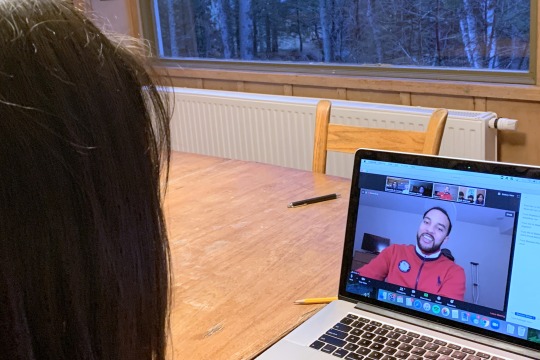

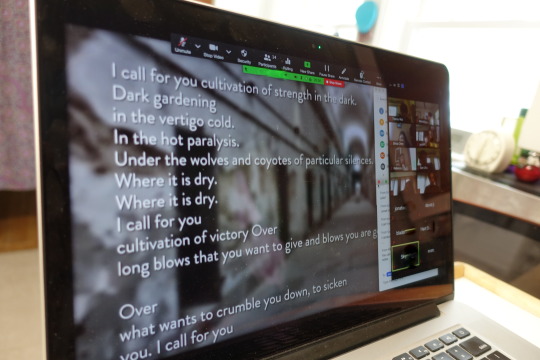
Top: Cocona meets an Olympian on Zoom. Middle: 9th-grade English class poem. Bottom: Meredith teaches 9th-grade English class.
Japanese teacher Meredith and school nurse Shannon worked together this week to connect a US Olympian to several of our on-campus students. Four of our Japanese students, along with several other on-campus students, had the opportunity to talk over Zoom with Chris Kinney—a bobsledder on the US Olympic team whose grandmother is Japanese and who has worked in Japan. Chris competed in the 2018 PyeongChang Olympics and will be competing in Beijing in 2022. The students were able to ask Chris questions in both Japanese and English, and learned about what life looks like for an Olympic athlete.
Meredith’s 9th-grade English class has been studying poetry over the past two weeks, examining the different ways writers throughout history have used poetic writing to translate the human experience, and applying that concept to the challenges of our own time. This past week, the class read the poem “To Prisoners” by Gwendolyn Brooks, and watched a video of other writers and former prisoners discussing the work and its impact on their own lives. The class has also been working on their own poems about their experiences in nature. Below, find an excerpt from 9th-grader David’s untitled villanelle poem:
Then, I thought in the dark
I pictured myself, under an ice shelf, just by myself
I think, I reflect, I want to restart
Can't see trails, but I followed my heart
The light, it shines, in myself,
I came, I saw, I came, I saw the art
I think, I reflect, I want to restart
A PLACE TO PLAY


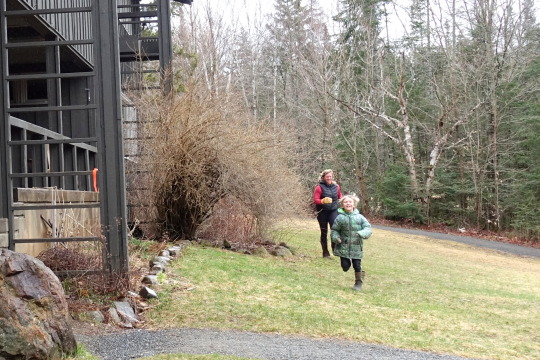
Top: Rebecca roasts a marshmallow. Middle: Roasting marshmallows. Bottom: Nurse Jess and her son, Wyatt, in a running race.
While life on the NCS campus may look different in many ways, students and adults are still getting in plenty of outdoor playtime. This past week, the students living in Cascade House made homemade marshmallows, and then roasted those marshmallows over a campfire by one of our lean-tos. Nurse Jess and her son, Wyatt, also took the time for a fun outside activity, participating in a “race around your house 5k” at the suggestion of Wyatt’s local elementary school.
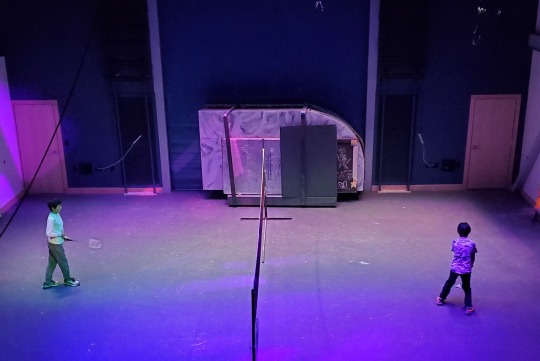



Top: Badminton with stage lighting. Middle 1: Participating in the Saturday Night Activity from home. Photo Credit- Jane Mellow. Middle 2: Student Ella and her brother, Pete, participate in Harry Potter LARPing. Bottom: A clue from the Harry Potter LARPing activity.
Our students and adults put their creative spin on play this week, adding fun and surprising elements to more traditional activities. During out-time this week, the students living in Mountain House played badminton under colorful stage lighting in The Walter Breeman Performing Arts Center, which added an extra layer of drama to the competition. This week’s Saturday Night Activity brought our on- and off-campus community together to participate in a bridge-building competition using unconventional materials. Students, teachers, and alumni used spaghetti, string, tape, and a marshmallow to build their structures, with the students of Cascade House declared the ultimate winners of the competition. Our on-campus community also spent this past Saturday participating in a Harry Potter live action role playing quest organized by teachers Courtney and Melissa and farm intern Bri. Students and teachers were divided into Hogwarts Houses and given clues to locate and decipher at various spots around campus. Students traveled around our campus trails, exploring outbuildings and participating in battles in order to complete their magical adventure.
NCS AT HOME

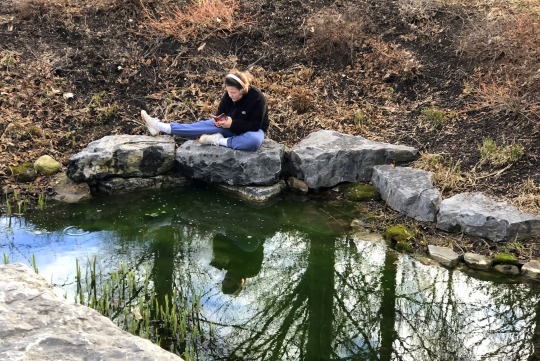

Top: 9th-grader Bladen hikes Hurricane Mountain. Middle: 7th-grader Olivia does work from home. Bottom: Olivia participates in the NCS rainbow hunt activity.
Though the majority of our students are in their respective homes around the globe, we have been thrilled to see that they are still engaging in NCS skills and interests with their families. We have loved hearing from our long-distance community members as they explore the outdoors, cook, and engage in creative work. This week we received updates from 9th-grade day student Bladen, who hiked to the summit of nearby Hurricane Mountain with his mother, and from 7th-grader Olivia, who did some schoolwork beside a pond and participated in the NCS Find a Rainbow Challenge with her family.
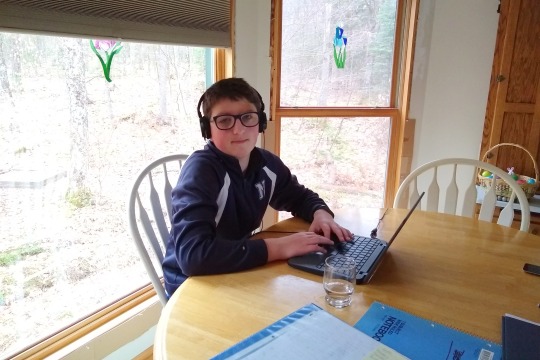


Top: 7th-grader JT completes school work from home. Middle: 7th-grader Colton bakes the “What’s Cooking?” blueberry muffin recipe. Bottom: Sisters Dominica and Kalina bake a berry pie.
This week we also received updates from 7th-grader JT, who has been participating in his online classes from his local home as well as making progress on his fiber arts knitting projects. 7th-grader Colton and sisters Dominica and Kalina have been practicing their Edible Schoolyard skills with their families, with Colton baking the blueberry muffins featured on the “What’s Cooking at NCS/CTT” blog, and Dominica and Kalina cooking up a pot of egg drop soup and baking a colorful berry pie.
FARM AND GARDEN



Top: Farm intern Nick harvests greens from the aeroponics room. Middle: Garlic sprouting in the field. Bottom: Spinach in the greenhouse.
Our barns and growing spaces have been busy with activity this week, with new green growth in the fields and the exciting start to harvesting in our aeroponics room. Farm interns Nick and Bri cut the first arugula, spinach, and mizuna greens from our aeroponic towers this week, and the delicious greens—which are grown without soil—were enjoyed in meals prepared by our kitchen staff.
Out in the fields, we saw the first bright green garlic shoots pushing through their mulched beds. The garlic was planted last fall by our 7th-grade Edible Schoolyard students, and welcoming the resilient crop after many months covered by snow and ice was an optimistic sign of good things on the horizon, as well as a warm reminder of the many hands that made light work of planting that crop. In the greenhouses we continued to harvest vibrant spinach greens, and look forward to the upcoming weeks when a bounty of herbs, greens, vegetables, and flowers will be filling the greenhouses and outdoor garden beds.




Top: Noni cares for the horses. Middle 1: Goats in the horse barn. Middle 2: Undyed spun wool. Bottom: Dyed wool hanging in the fiber arts studio.
Down at the barn, art teachers Noni and Katie have been helping Barn Manager Erica care for our many creatures, prepare our ewes for the upcoming lambing season, and ready our wool for use. Noni spent some time in the pasture with our horses, lending a hand with some necessary grooming as the herd sheds their thick winter coats. Meanwhile, our goats paid a social call to the horse barn, enjoying a snack of hay in the foyer. Erica and Noni also worked on skirting, or cleaning, our wool fleeces this week, as well as preparing our spun yarn for use in the fiber arts program. The spun scanes of yarn were brought to the art studio for dyeing and drying, and will soon be ready to be turned into students’ and campers’ future weaving and knitting projects.
We hope that you and your loved ones are staying safe and healthy, and that your communities are caring for and supporting one another. We will continue to update you about our community throughout this time, and encourage you all to reach out to us as well.
CONNECTING WITH OUR COMMUNITY:
Mondays: Check our Facebook page every Monday for a video from our School Counselor, Lauren, on tips for getting through this challenging time.
Tuesdays: Creature Query- Barn Manager Erica Burns will be answering questions about the animals on our farm using fun and educational videos. This week Erica taught us how to prepare our sheep’s wool for spinning. Check it out on our Facebook page.
Wednesdays: What’s Cooking at NCS and Camp Treetops?- Edible Schoolyard instructor Elie Rabinowitz, along with other community members, will provide simple recipes and cooking resources you can use to prepare delicious meals at home with your families. This week Garden Manager Tess will share a garden-fresh spinach and feta frittata recipe, and next week Head of Kitchen Paulette will show us how to make sticky buns. Check out all of the recipes on Facebook and on Tumblr.
Thursdays: Birding with Jack- 6th-grade English teacher Jack Kiernan will offer the NCS community an opportunity to connect through the world of birds by providing the resources to become familiar with birds that our community is seeing around the globe. If you are out for a walk or sitting at home, looking out the window, take a moment to log the birds you see with the NCS eBird account. Jack will provide videos and information about birds being logged, as well as birds he is seeing on his daily birding adventures! Check it out on our Facebook page and on Tumblr.
Fridays: Check our Facebook page every Friday for a video featuring a Japanese mini-lesson by teacher Meredith Hanson. This week Meredith talked about forest bathing, a Japanese practice of calmly being in nature.
Saturdays: The NCS Saturday Night Activity- Every Saturday at 8 p.m., NCS teacher Larry Robjent, along with other NCS faculty, will be hosting fun activities similar to those typically held on campus with students. Participate live from home with your own families. Last week, Larry and English teacher Melissa Orzechowski built bridges using 20 sticks of spaghetti, one yard of string, one yard of tape, and one marshmallow. This week, Larry and a guest host will run a reverse auction.
For more information about the #ThisWeekAtNCS blog, contact Becca Miller at [email protected].
For general school information, call 518-523-9329 or visit our website: www.northcountryschool.org
0 notes
Text
Physical Therapists’ Perceptions of Learning and Implementing Acceptance and Commitment Therapy (ACT) to Treat Chronic Pain: A Pilot Study on the Integrative Pain Science Institute Experience
Chronic pain presents a physical and psychological burden for millions of Americans, and is a global health pandemic. This burden has been worsened by the widespread emphasis placed on a biomedical approach that largely neglects to address the psychosocial components and processes of chronic pain. This omission has led to poorly managed pain, the chronification of pain, and the misuse of pharmaceutical medications and invasive procedures (1). Research has shown that the main predictors of pain chronification (i.e. the process by which acute pain becomes chronic), are social and psychological factors, rather than purely biomedical. (, 3). If not properly addressed, these factors negatively impact pain treatment, decrease the efficacy of interventions, and are related to poor functional outcomes and quality of life. This highlights the urgent need for comprehensive pain management approaches that address biomedical factors along with cognitive and behavioral obstacles to pain rehabilitation efforts.
Physical therapy is often the first point of entry into the healthcare system for people experiencing pain. The non-invasive and non-pharmacologic approach taken by physical therapists towards the treatment of pain makes the professional ideally suited to adopt evidence-backed technologies of psychologically-informed pain care traditionally neglected by standard biomedical treatments. Indeed, physical therapists are now expected to recognize pain associated with psychosocial distress (yellow flags) and to modify their treatment approach accordingly (4, 5, 6). However, available studies have indicated that the psychological aspects of pain are insufficiently addressed in entry-level physical therapy education programs and current clinical practice settings (7). Results of a 2015 nationwide survey that evaluated the extent of pain education in entry-level physical therapist education programs revealed that only 2.7 contact hours on average were devoted to psychological management of pain (8).
Mounting evidence suggests that incorporating principles of cognitive behavioural therapy (CBT), including Acceptance and Commitment Therapy (ACT), into standard physical therapy treatments can be effective and address the psychological distress associated with chronic pain (9, ). ACT (said as one word) is a process-based, third-wave, cognitive behavioral therapy (CBT) that has shown its effectiveness for both physical and mental health conditions. ACT uses acceptance, mindfulness, commitment, and behavior change strategies to increase psychological flexibility. Psychological flexibility can be defined as contacting the present moment, and based on the situation, changing or persisting in behavior in the service of chosen values. This is established through six core processes including acceptance, defusion, present moment awareness, self-as-context, committed action, and values. The aim within ACT is to reduce the dominance of pain in a person’s life through the development of psychological flexibility.
Unlike pain neuroscience education, and other psychological approaches, ACT does not focus on pain reduction, changing thoughts or modifying pain beliefs – even though this may occur. The ultimate goal in ACT for pain is to defuse from the influence of language and cognition over behaviour and support the clarification of values, so those living with pain can take action and return to a rich, full, and active life. An ACT informed approach to pain care does not seek to stop, eliminate, or control pain, but instead, an ACT practitioner fosters an open approach toward human pain and suffering, and redirects behavioural repertoires inline with personally held values and goals. One of ACT’s greatest strengths lies in its ability to address pain-related anxiety and depression, as well as improve functional outcomes among a variety of chronic pain populations (11, 12).
The incorporation of cognitive and behavioural techniques such as ACT into the praxis of physical therapy allows professionals to apply Psychologically Informed Physical Therapy (PIPT), a biopsychosocial approach to pain rehabilitation. PIPT integrates principles of pain psychology into conventional physical therapy evaluation and treatments, and imparts cognitive-behavioral skills to help patients effectively self-manage pain. (13). However, the adoption of PIPT is dampened not only by the mentioned gaps in pain education in current entry-level physical therapy curricula, but also by reports of inadequate professional training provided post-graduation, a recurrent issue arising in past efforts to train physical therapists in the use of biopsychosocial interventions (14, 15, 16).
The Integrative Pain Science Institute (IPSI) recently conducted a physical therapist-led ACT for Chronic Pain course aimed at training physical therapists and other licensed healthcare professionals who treat pain. This pilot study summarizes and discusses results of a post-course survey that sought to answer the following research question: What are physical therapists’ perceptions of learning and implementing ACT for chronic pain to treat musculoskeletal pain conditions?
Study: Materials and Methods
Study design. An ACT for chronic pain course was taught by a physical therapist (JT) with over 25 years of training post-graduate physical therapists in integrative pain care. The course was delivered online over 8 weeks. New content was delivered weekly via email and total training time was 30 hours. The course was directed to physical therapists and other pain practitioners, and a total of 65 enrollees completed the course. Over 90% of course participants registered identified as physical therapists. The remaining participants included psychologists, occupational therapists, nurses, and health coaches Participants could review the training materials as many times as desired. Training also included 4 live group web-conference coaching calls (120 min each) which consisted of questions and answers, role playing, experiential exercises, and discussion of situation-specific intervention approaches. One call was conducted 4 weeks into the course, another at the end of the course (8 weeks), and the remaining two calls were held after the course’s end date at week 12 and week 16, respectively. In addition, an online forum was set up for open networking and open communication between trainer and trainees in between the coaching calls.
The training focused on teaching theoretical and practical aspects related to the core principles of ACT: 1) Relational frame theory, functional contextualism, and the science supporting ACT; 2) workability and experiential avoidance; 3) present moment awareness and self-as-context; 4) defusion; 5) acceptance; 6) values; 7) committed action; and 8) a practitioner manual and protocol for use use in the clinic. Each topic included examples of metaphors and activities to effectively deliver ACT for chronic pain in the context of physical therapy practice. A tool to self-rate the basic ACT therapeutic stance and core competency was also provided as a measure of self-assessment. A full review of the training outline can be found here.
Course evaluation. At the end of the course, participants were asked to complete a voluntary 15-question online survey indicating their satisfaction with the training as well as their perceptions of learning and implementing ACT to treat musculoskeletal pain conditions. The survey was anonymous; no identifiable data on any individual was collected. The course survey questions were modeled after the overview of themes and sub-themes described by Holopainen et al., with regard to learning and implementing a biopsychosocial intervention in the management of musculoskeletal conditions (14)
RESULTS
Participants’ evaluation of the ACT course for chronic pain was conducted via an anonymous survey administered four months after the course’s end (see Table 1). The survey, completed by 25 participants, sought to obtain participants’ valuation of the training received, as well as a preliminary measure of its effectiveness upon translation into real-world practice environments. Participants’ perceptions about the course were highly positive. Relevant points identified from survey responses included:
Question #2: 100% of participants reported learning foundational ACT skills necessary to implement it into physical therapy practice.
Question #3: 100% of participants reported indicated that the training furthered their understanding of psychological factors involved in musculoskeletal pain.
Question #7: 86% of participants reported agreed that the training increased their confidence level in managing musculoskeletal pain.
Question #9: 91% of participants reported agreed that the training led to improved job satisfaction.
Question #11: 95% of participants reported reported that the training was useful for clinical practice.
Question #12: 100% of participants reported indicated that the training helped them implement a new approach to treating musculoskeletal pain.
In addition, 7 relevant sub-themes regarding the ACT training emerged from the open-ended question #15 (What was your overall impression of the course?) See Table 2 for a full list of open-ended question responses.
The training filled a knowledge gap in understanding of how to assess and treat psychological factors related to pain.
A mixture of prerecorded video training, reading, and experiential exercises were critical to reinforce learning.
Coaching calls were a useful part of the training and helped to translate course knowledge and implement into clinical practice.
Having an opportunity to practice in a group setting with like minded peers was a critical component of confidence building.
Ongoing communication, networking, and mentorship via the online forum allowed participants to complete the course material on-time, stay connected, and share stories and experiences about implementing the material in practice.
The ACT stance of not changing pain or related psychological content (example: not changing thoughts, pain related beliefs, reconceptualizing pain) may run counter to other psychologically informed approaches found in physical therapy practice and took some time for practitioners to process and integrate with other pain education and psychosocial theories of pain.
Some practitioners expressed that ACT helped them cope with work-related stress and burnout and to drop the struggle of fixing or curing every patient with pain.
Q15: What was your overall impression of the course? What went well? What could have been improved?
20/25 participant responses.
Participant #1: “Wonderful course! I thought the pace and content volume for each section was excellent— plenty of content to go back to mull on while also immediately applicable if I went through certain sections more quickly. ACT provides a hope-filled and very personal, client-specific approach to moving towards a life of patient-identified-meaning in spite of the presence of chronic pain. I especially appreciated live coaching calls—it was very useful to discuss as well as practice ACT with others who are learning ACT.”
Participant #2: “Course was great. Coaching calls were really helpful, and made me feel supported. Self assessment was also really nice. It would be cool if the self assessment could happen online and compare your answers from beginning to end.”
Participant #3: “Excellent, strong resources, great support via coaching calls, very open and accepting teacher!”
Participant #4: “Well designed & taught. good patient examples a lot of information that I need to review over & over so I’m grateful its online & accessible to me. If possible, could a real time or taped interaction be shown of therapist & client going through various ACT concepts.”
Participant #5:“I liked the format! Perfect to fit into work schedules. The calls were interesting although I only attended 1 live. I appreciate having the link even after the course. Life event and COVID had me a little distracted in the last week. I’ve done CBT for 30 yrs so this is a shift… “
Participant #6: “You do a wonderful job with the metaphors and meditations. I would like to see them in an audio format to assign and share with my clients until I am more comfortable doing on my own. It was a very well done class. Thank you!”
Participant #7: “This course was awesome, and Joe is absolutely amazing. I’ve taken enough courses where the content is good, but it feels like the instructor is very tunnel vision focused on their method (and nothing else), and the course is just a money maker to them. This was completely different. Joe is clearly an exceptionally skilled, knowledgeable and compassionate clinician and teacher who truly cares about his students. I am so incredibly grateful to him and this course. This content is going to take time to absorb and feel competent in, but I can tell it is going to be well worth the effort and discomfort of being out of my comfort zone. Thanks, Joe for being so generous with your knowledge and time!”
Participant #8:”Great course, happy to recommend”
Participant #9: “Went well. I am a health coach and have lived with CRPS and chronic pain since 1994. found info helping when coaching and running support group. similar to what i did way back when to move forward.”
Participant 10: “It was great overall. Thank you”
Participant 11: “Excellent course with great support through the online group and the coaching calls.”
Participant 12: “Need more practice at it but everything was really great!”
Participant 13:”Loved it. I can’t think of any improvements needed. Great content and usable handouts for immediate use. Thanks!”
Participant 14: “I liked the layout of the course with mixture of webinars, exercises and written information. I particularly liked that we were able to download information to use with clients. There is a lot of information to cover and I feel that I need time to practice and go through it more in my own time to feel that I can implement it successfully with patients and work towards the outcomes we intend together, it does take a bit of a paradigm shift in some respects as a physiotherapist and I think I have to give myself time and permission to work at it. I really enjoyed the content and feel excited about using it and further enhancing my ACT knowledge and experience, thank you!”
Participant 15: “I was impressed with the overall content. I thought examples of real patient interaction – in a written dialogue format – for each of the 6 elements of ACT would have been helpful”
Participant 16: “I really enjoyed this course. Not only does it enhance my PT practice with regard to chronic pain patient care, but it is helpful for EVERYONE, myself included. I liked the flow of the course from week to week, and how previous ground would be reinforced as skills and concepts were built upon. I definitely need to work more with the material to develop proficiency, but this was a sound foundation.”
Participant 17: “I really liked the course. As a support group leader and individual with chronic pain I think it is very fitting in teaching one not to ignore their pain but to focus on what’s important to them to move forward. We all have a right to live the life we want.”
Participant 18: “This course was exactly what I needed. It filled my knowledge gap on how to put my understanding of how the brain works into practice with my patients. Prior to taking the course, I had been listening to many lectures on the new findings of how the brain/behavior works, as well as watching Robert Sapolsky’s Stanford course on “The Biology of Human Behavior” (25 lectures posted on youtube). I found this base knowledge necessary for implementing the course as well as I have. I feel that some review of neurology and basic brain function (or references for self study) may be helpful to better implement the strategies presented. Thank you so much for this course. I don’t think there is anything else like it out there.”
Participant 19: “I thought the course content was very thorough and provided me with a comprehensive understanding of ACT.”
Participant 20: “Helpful and excellent course.”
The results of this small pilot course and training experience adds to the existing literature and confirms the value of specific training provided to foster psychologically-informed skills using ACT for physical therapists and other pain practitioners.(17).
FREE Download: The 5 Pillars of Pain Care Dr. Tatta’s simple and effective pain assessment tools. Quickly and easily assess pain so you can develop actionable solutions in less time.
Download
DISCUSSION
Chronic pain continues to impose a huge toll on the economic, social, and mental wellbeing of those affected. Despite wide recognition of the necessity for alternative treatment options, adoption of psychological strategies by healthcare professionals, including physical therapists, lags well behind medical innovations and drug-based approaches that are generally costly, potentially dangerous, and oftentimes ineffective. To properly conceptualize and implement into practice the biopsychosocial principles of patient care, physical therapists need to evaluate and be prepared to address a multitude of biological, psychological, cognitive, and social factors.
The usefulness of ACT delivered by physical therapists to improve pain self-management and quality of life in people living with pain is supported by recent research (9, , 16). A recent RCT contrasted outcomes of Physical Therapy informed by ACT (PACT) versus usual care Physical Therapy for adults with chronic low back pain. Results showed that PACT was associated with significantly higher short-term improvement in disability, patient specific functioning, physical health, and treatment fidelity (9). Meanwhile, a single-arm study that evaluated outcomes of an 8-week program of combined exercise and ACT directed to chronic pain patients reported improvements in most outcomes post‐intervention and maintenance of many changes at one-year follow-up ().
However, many efforts to train physical therapists in biopsychosocial interventions have so far fell short of expectations, leading to incomplete understanding and fragmented delivery of psychologically-informed care. Recent research reviewed 12 published studies to evaluate physical therapists’ perceptions of learning and implementing biopsychosocial interventions to treat musculoskeletal pain. The conclusions stressed that although physical therapists “reported a shift towards more biopsychosocial and person-centered approaches, the training interventions did not sufficiently help them feel confident in delivering all the aspects” (of the specific therapies) (14). Another study reviewing 5 controlled randomized trials (CRT) concluded that “with additional training, physiotherapists can deliver effective behavioral interventions. However, without training or resources, successful translation and implementation remains unlikely” (15). In addition, a pioneer effort to implement ACT into a physical therapy-led pain rehabilitation program underscored that physical therapists were uncomfortable with the shift from “fixing” towards “sitting with”, proposed by the ACT principles (16). Therefore, although physical therapists are in a key position to treat pain conservatively, and prevent overuse of both over-the-counter and prescription analgesics for chronic pain conditions through cognitive/behavioral methods, there is a clear need to provide them with quality training that maximizes the chances for effective translation into practice.
Importantly, the feedback provided by physical therapists who completed our training on ACT for chronic pain indicated both high satisfaction with the training provided and increased confidence in delivering ACT in their practice. Although the window of time provided to assess whether the learned contents could be effectively translated into practice was limited (answers to the questionnaire were recorded four months after the course’s end), all participants agreed that the training was optimal and the course helped them to implement a new approach for the treatment of pain. Future studies should explore treatment fidelity, long term outcomes, and the development and validation of a scale to measure knowledge and concepts, skills and techniques, and conceptualizing psychological flexibility within physical therapist practice.
In conclusion, both our own and previous experiences strongly suggest that ACT may be very valuable to adapt to the practice of physical therapy and the complex clinical and psychosocial environments represented by many chronic pain conditions. To this end, expert training and counseling in delivering ACT within PIPT precepts will help pain practitioners to provide effective treatment and improve the quality of life for people living with pain.
Acknowledgements
The author wishes to thank the professionals who responded to the course survey and for their commitment to improving the delivery of safe and effective pain care.
Funding
The author received no specific funding for this work.
Declaration of interest
Joseph Tatta receives fees for providing clinical workshops for health care professionals in the management of musculoskeletal pain.
Suggested Citation
Tatta, J. (2020) Physical Therapists’ Perceptions of Learning and Implementing Acceptance and Commitment Therapy (ACT) for Chronic Pain: A Pilot Study on the Integrative Pain Science Institute Experience. New York, NY: Integrative Pain Science Institute. Retrieved from: https://ift.tt/31Il0mz
Joe Tatta, PT, DPT is the Founder of the Integrative Pain Science Institute, a company dedicated to reinventing pain care through education, research, and professional training. He has 25 years of experience in physical therapy, integrative models of pain care, leadership, and private practice innovation. He holds a Doctorate in Physical Therapy, is a Board-Certified Nutrition Specialist, and ACT trainer.
REFERENCES
1- Tompkins, D. A., Hobelmann, J. G., & Compton, P. (2017). Providing chronic pain management in the “Fifth Vital Sign” Era: Historical and treatment perspectives on a modern-day medical dilemma. Drug and alcohol dependence, 173 Suppl 1(Suppl 1), S11–S21.
2- Chou, R., & Shekelle, P. (2010). Will this patient develop persistent disabling low back pain?. Jama, 303(13), 1295-1302.
3- Theunissen, M., Peters, M. L., Bruce, J., Gramke, H. F., & Marcus, M. A. (2012). Preoperative anxiety and catastrophizing: a systematic review and meta-analysis of the association with chronic postsurgical pain. The Clinical journal of pain, 28(9), 819-841.
4- Dowell, D., Haegerich, T. M., & Chou, R. (2016). CDC Guideline for Prescribing Opioids for Chronic Pain–United States, 2016. JAMA, 315(15), 1624–1645.
5- British Pain Society. (2013). Guidelines for Pain Management Programmes for adults. Retrieved from https://ift.tt/3e17Fbg
6- Zadro, J., O’Keeffe, M., & Maher, C. (2019). Do physical therapists follow evidence-based guidelines when managing musculoskeletal conditions? Systematic review. BMJ open, 9(10), e032329.
7- Hoeger Bement, M. K., St Marie, B. J., Nordstrom, T. M., Christensen, N., Mongoven, J. M., Koebner, I. J., Fishman, S. M., & Sluka, K. A. (2014). An interprofessional consensus of core competencies for prelicensure education in pain management: curriculum application for physical therapy. Physical therapy, 94(4), 451–465.
8- Bement, M. K. H., & Sluka, K. A. (2015). The current state of physical therapy pain curricula in the United States: a faculty survey. The Journal of Pain, 16(2), 144-152.
9- Godfrey, E., Wileman, V., Holmes, M. G., McCracken, L. M., Norton, S., Moss-Morris, R., … & Critchley, D. (2019). Physical therapy informed by Acceptance and Commitment Therapy (PACT) versus usual care physical therapy for adults with chronic low back pain: a randomized controlled trial. The Journal of Pain.
10- Casey, M. B., Cotter, N., Kelly, C., Mc Elchar, L., Dunne, C., Neary, R., … & Doody, C. (2020). Exercise and Acceptance and Commitment Therapy for Chronic Pain: A Case Series with One‐Year Follow‐Up. Musculoskeletal Care, 18(1), 64-73.
11- Sturgeon, J. A. (2014). Psychological therapies for the management of chronic pain. Psychology research and behavior management, 7, 115.
12- Veehof, M. M., Oskam, M. J., Schreurs, K. M., & Bohlmeijer, E. T. (2011). Acceptance-based interventions for the treatment of chronic pain: a systematic review and meta-analysis. PAIN®, 152(3), 533-542.
13- Keefe, F. J., Main, C. J., & George, S. Z. (2018). Advancing psychologically informed practice for patients with persistent musculoskeletal pain: promise, pitfalls, and solutions. Physical therapy, 98(5), 398-407.
14- Holopainen, R., Simpson, P., Piirainen, A., Karppinen, J., Schütze, R., Smith, A., … & Kent, P. (2020). Physiotherapists’ perceptions of learning and implementing a biopsychosocial intervention to treat musculoskeletal pain conditions: a systematic review and metasynthesis of qualitative studies. Pain.
15-Hall, A., Richmond, H., Copsey, B., Hansen, Z., Williamson, E., Jones, G., … & Lamb, S. (2018). Physiotherapist-delivered cognitive-behavioural interventions are effective for low back pain, but can they be replicated in clinical practice? A systematic review. Disability and rehabilitation, 40(1), 1-9.16- Barker, K. L., Heelas, L., & Toye, F. (2016). Introducing Acceptance and Commitment Therapy to a physiotherapy-led pain rehabilitation programme: an Action Research study. British journal of pain, 10(1), 22–28. https://ift.tt/3gspy4G
The post Physical Therapists’ Perceptions of Learning and Implementing Acceptance and Commitment Therapy (ACT) to Treat Chronic Pain: A Pilot Study on the Integrative Pain Science Institute Experience appeared first on INTEGRATIVE PAIN SCIENCE INSTITUTE.
This content was originally published here.
The post Physical Therapists’ Perceptions of Learning and Implementing Acceptance and Commitment Therapy (ACT) to Treat Chronic Pain: A Pilot Study on the Integrative Pain Science Institute Experience appeared first on METAMORPHOSIS.
from WordPress https://ift.tt/2VGKpcb via IFTTT
0 notes
Text
eCom Challenges Review
eCom Challenges Review (Thaddeus Strickland Course)
Today, we’ll be reviewing Thaddeus Strickland’s eCom Challenges course on dropshipping. It sells as a single stop to learn all the knowledge you need to start and scale your own eCommerce venture.
After reading this review, you’ll be able to tell if that’s statement is true or not. As always, you can jump right into my conclusion, but I’d recommend you read the entire review to make a more informed choice.
Who’s the author?
According to Thaddy, he’s a “serial entrepreneur”, and he’s from the US. He creates content and store as well as software he sells as is source of income. This course works as an in-depth extension of the content provided by his videos on YouTube.
His popularity has grown quite a bit in recent months, and if you’re used to watching dropshipping content, you’ve probably seen his channel among your recommendations. He’s nearing the 40,000 subscribers mark, and his content focuses on tutorials and strategies for making money through dropshipping.
His Instagram account @thaddy is also quite active, and he passed the 43,000 subscribers milestone months ago. His content there is somewhat more personal in that he mostly shares the luxurious lifestyle he’s been able to afford with his ventures.
You can see different advertisements and posts promoting his course on Instagram if you’re used to following this business style.
Reviewing eCom Challenges
eCom Challenges features 92 different videos among 23 modules, so it’s a bit on the longer side of dropshipping courses. You can pay and access the course on Teachables, so the videos are high quality and responsive.
The course itself presents as a challenge, and the idea is to provide you with a more entertaining approach to learning the business model.
Intro
Module 1 introduces you to the program. It’s your basic overview of what you can expect and the invitation to join the FB group, where you can post any doubts you might have for other students to help you.
Thaddy’s approach
This module offers 3 videos showing you how Thaddy creates his ventures. You learn different methods for creating your store, how to pick your theme, which widgets Thaddy recommends, among other things.
Recommended programs
In the 3rd module, you’re recommended several tools you can use to make your store more effective. Included here, we have Facebook and its advertisements to attract more customers. You have a lesson on how to test your ads (run several at the same time) and how you can catch visitor leads to reduce your workload automating and driving your sales.
Finding and validating products
This is your product research module, and Thaddy explains here how you can find products with certainty that they’ll sell. You also learn how to move said products into your store from online marketplaces (i.e. AliExpress), and he also goes into tools to facilitate this task, like Oberlo.
There’s also a lesson on using data from AliExpress to validate your ideas, one on how to look for new chances with Google Trends, and a last one on how to use Facebook’s search bar to look for the items that other stores are selling with success.
Marketing
Module 5 is just 2 videos on how you can market your store through Instagram.
It goes into how to use influencers on the platform to sell to their already-built audiences. There are also lessons now other Instagram-related strategies to expose your products to potential customers.
Optimizing your pages
You have 2 videos with a strategy on each to improve the pages for your products. The first one teaches you how you can find the best stock images using AliExpress.
The second one is about the lifecycle of your products. That’s basically what you can expect from your products when you list and sell them through a store.
Launch preparations
This module’s purpose is to go through what to do regarding orders, before and after they start coming in.
The lessons cover how to fulfill your orders, how your Instagram funnel should be (it’s essentially just the entire process your customers go through from your ad to buying your offer), the proper way to price your listings, and when/how to scale your store.
Important considerations
Modules 8 and 9 go into different scenarios and considerations you should keep in mind while running your business. It’s a very interesting section, but it’s more theory than anything you can actually put into practice.
You have lessons on what you should do if your store doesn’t get conversions, how using influencers has evolved through time, how to spot good influencers, a simplification of the dropshipping business model, and comparison between low, mid, and high ticket items.
You also have a lesson on how to make your store look clean and flawless, and a few theoretical videos responding questions like why you should use free+shiping, why working with large influencers, and why the most important sales quarter of the year is Q4 (October, November, December)
Facebook strategies
This module introduces us to Noah, who’s been invited to provide the Facebook training with a few advertising tactics.
The first approach you learn is how to use lookalike purchases to increase your conversions. There are also 3 videos explaining the process of setting up a funnel on Facebook to ensure sales for the products you promote through Facebook.
Product photos
This is a short module on how to take great-looking photos for under $10. You learn why the white background matters and how to speed up your photos.
Designing
This is kind of the continuation of the previous module, and it goes into editing and altering your photos as well as your store’s logo and design in general.
You have lessons on presets, manually editing your photos, how Thaddy designed his first logo, and why you want to pay attention to dimensions if you want to display your images properly.
Payments
Module 13 talks about payments in 2 videos. You have one about Shopify’s issue of holding payments (when Shopify keeps your money on hold after customers buy from you) and how to solve it, and the other one is about setting up your payments properly to get your funds faster.
Facebook Ads types
This lesson goes into the different types of Facebook ads you have at your disposure for marketing your products.
You learn about how to set up your Facebook Pixel, carousel and dynamic ads, retargeting ads, and custom and lookalike audiences.
I get why this content wasn’t included in the previous Facebook Ads module, but it definitely feels off to have them separated by 3 modules with nothing to do with the topic.
Facebook Ads strategies (again, it seems)
And it gets worse since then you have another module discussing strategies you can employ with the different types of Facebook ads you already learned. I was really distracted by this, but I doubt this will be a problem for everyone.
I just don’t like when courses’ structures look random.
Anyways, here you learn about a “3-ad objective” strategy, how you can stop spending money marketing to individuals who aren’t likely to buy, and how to get ideas for your images and captions.
Bull-rush
This module goes into a strategy used by Thaddy to boost his conversions. It revolves around analyzing your data, and the lessons explain to you what the strategy actually is and what requisites you need to meet if you want to use it.
Scaling
Module 16 is about why you want to outsource your work and how to do it. It’s essentially how you get to scale your store and spend less time on it while generating more money.
You learn how to test, self-scale, and some software that you can use to run your ads with less time and effort when testing. You can apply this knowledge yourself, but there’s also content on how to hire others to do this for you so you can focus on other tasks.
Influencers
This is the most substantial module in the course, and it focuses on Facebook and Instagram, as you might have seen coming throughout the course. However, FB influencers are a lot more underestimated than Instagram��s.
You’re introduced to another friend of Thaddy, whom he calls JT. The claim is that he made $45,000 in just one day, and this module gives you a motivational message from JT, but it also gives you a summary of how he did it. He focused on influencers.
You basically learn what they are and how you can find the most effective, both paid and free. You also learn how to reach out to them and get them to shout out your products.
The final videos are about how to work into a long-term partnership and how you can use the 2 platforms discussed efficiently.
Again, I don’t see why this section was separated from the other two. The Instagram marketing section was around 3 modules before the first Facebook strategies, and some of you might get lost with all the content in-between.
And there’s a final hit.
How to use Instagram
The closing 2 modules of the course are about how to use Instagram effectively, right after you learn how to use it with influencers, and 14 modules after the one about Instagram marketing.
You learn how to decide if you should automate your process and how to do so, using automated direct messaging, “Shadowbans” and how to avoid them, using hashtags efficiently, how to manage your growth, leveraging Instagram highlights and making logos or covers for them, how other brands are using highlights effectively, how to set up autocomment, and getting free traffic.
Bonuses
The bonuses come with a handful of guides and files you can use to make your entrepreneurship easier.
You have a directory with over 150 dropshipping companies in the US, a checklist, a list of the best 500 stores on Shopify, Thaddy’s favorite 30 influencers on Instagram, and some presets for both mobile and desktop you can use on your site.
Final Verdict
Is It Worth It? Final Verdict
This course falls where most courses do so: providing enough depth. It definitely covers more ground than your standard dropshipping guru, but it’s still weak when it comes to providing actual depth instead of an overview.
It also fails to provide examples of the concepts being applied instead of just telling defining them and telling you how they should work.
However, the worst offence is the course structure. It feels like Thaddy didn’t really think about the appropriate order of the modules, and if you want to understand everything, you’ll probably find yourself jumping through the different modules, back and forth, not to forget anything between related modules.
Finally, it’s too expensive. You have courses like eCom Elites you can buy for as low as $197, and it offers a bit over twice the amount of content here, and it provides a lot more depth that’s well-structured.
I hope you found this review useful and if you have any questions, please comment down below. I’ll be more than happy to assist you.
Once again, thanks for reading my eCom Challenges Review and I wish you the best of luck.
The post eCom Challenges Review appeared first on Only Genuine Reviews.
source https://www.onlygenuinereviews.com/ecom-challenges-review/ source https://onlygenuinereviews.tumblr.com/post/190321868937
0 notes
Text
"Young coders are shaping Singapore’s future"
You’re never too young to take up coding—just ask 10-year-old Sephia Rindiani Binte Andi. Sephia only took up coding a year ago, and sharpened her skills so quickly she created an online game shortly after. The game challenges players to navigate their way out of a maze (I admittedly kept getting lost). Today, Sephia continues dabbling in code at home with the help of her mom, Kamzarini.
Sephia is a graduate of Code in the Community, a program that brings coding classes to young Singaporeans from less affluent backgrounds. The grassroots initiative is run by local education organizations like Saturday Kids and 21C Girls, with the help of more than 1,000 volunteers and the backing of Google and Singapore's Infocomm and Media Development Authority (IMDA).
Since 2017, Code in the Community has reached more than 2,000 Singaporean students. And this week, we’re proud to announce that Google will provide a new grantto help expand the program for another three years.
Together with a matching grant from IMDA, the new funds mean two things: First, they’ll allow the program to bring basic coding classes to 6,700 more kids by 2022. Second, they’ll support new courses for the 2,300 existing graduates—encouraging talented young students like Sephia to apply what they’ve learned and explore new concepts like design thinking.
DPM
Singapore's Deputy Prime Minister, Heng Swee Keat (in yellow shirt), at the Code in the Community event on 4 January 2020
JT
John Tan, CEO and Co-Founder of partner organisation Saturday Kids
IMDA
Tan Kiat How, Chief Executive of IMDA, with young coders hard at work
CITC class
CITC graduates ready to shape Singapore's digital future
We hope Code in the Community will shape Singapore’s future as a smart nation, growing the city-state’s $12 billion internet economy—one of the most advanced in Southeast Asia—with new jobs and opportunities.
As a Singaporean myself, I’ve found it incredibly inspiring to see the way local communities have come together to make technology real, accessible and fun for children. I can’t wait to see what the next generation of graduates do as they develop their skills and go wherever their imagination takes them.
Source : The Official Google Blog via Source information
0 notes
Text
Chelsea legends John Terry and Frank Lampard could have been reunited at the beginning of season
Back in September, when John Terry had yet to hang up his boots, a reunion with Frank Lampard at Derby was mooted. "I would take John Terry all day, every day," said Lampard.
Instead, eight months later, Lampard will take on Terry in a match of enormous significance. The two close friends, team mates at Chelsea for 13 years of triumph and tumult, are set to stand in opposite dugouts at Wembley for the Championship play-off final on May 27.
Terry, of course, is Dean Smith's assistant and the spotlight will be on Aston Villa 's manager, who is on his own emotive journey. But it is impossible to ignore the delicious conflict between a pair who won so much together as players, now each in their first campaigns or coaching.
Derby boss Frank Lampard's guided his side into the play-off final after a brilliant win over Leeds
John Terry will go head-to-head with Lampard at Wembley after Aston Villa beat West Brom
PLAY-OFF FINAL
Date – May 27 (Monday)
Time – 3pm
Venue – Wembley
Channel – Sky Sports
Last summer Lampard couldn't do a deal for Terry because Derby had to cut the wage bill. A few weeks later Terry retired from playing and took up position assisting Smith alongside long-term colleague Richard O'Kelly.
Villa chief executive Christian Purslow knew Terry from three years working as Chelsea's head of global commercial activities and proposed his involvement with Smith, who was selected as the outstanding candidate to succeed Steve Bruce after an interview process including five candidates.
Smith had come across Terry while managing Brentford and Walsall, and also Terry's brother Paul at Leyton Orient . An hour-long FaceTime chat to refresh their relationship confirmed that joining up at Villa should work. "We decided it was right," Smith said. 'If it wasn't we both could have said no. But I felt it was a win-win. It was my decision. "
Terry arrived for his first day at 7.30am armed with his pencil case ready to take notes. He has shelves full of pads containing coaching details at his Surrey home, having studied Jose Mourinho and others, and continues to absorb information from a manager with more than 400 matches in the Football League.
'This is now his apprenticeship into coaching, he's going to get the hours in, "said Smith. "I'm quite flattered he's chosen to work with us." The learning has flowed both ways, with Terry's playing experience at elite level and Premier League contacts proving valuable.
Lampard and Terry became very close friends during their playing days at Chelsea
The pair won three Premier League titles and a Champions League together at Chelsea
His early starts continue, with daily commutes up to Birmingham, and he keeps himself in excellent shape, posting his healthy breakfasts on Instagram. Sometimes it is avocado, wholemeal toast (no butter), and bacon (fat cut off). Others it is a protein shake or spinach, coconut milk banana, and oats. He regularly goes for runs of 5km and upwards.
At Bodymoor Heath that fitness helps. He has joined in with five-a-side games and does occasional one-on-one coaching with defenders and attackers. "Put a clip or a tough drill with Tyrone Mings online.
" If you ask all of the defenders they will say they have benefited from having JT on the coaching staff, "Smith said last week. 'He gives a bit of technical, tactical and psychological advice. An awful lot of detail. "
Terry has respected Smith's authority and generally maintains a reserved presence, just as last season when he tried to stay out of the limelight by not doing captain's program notes.
He can come alive on the touchline though, as seen on the City Ground in March when he got into a splash with Roy Keane. Lampard had his own run-in with Keane in February, old hostilities dying hard evidently.
Jack Marriott celebrates after scoring the decisive goal for Derby against Leeds at Elland Road
Lampard has of course been much more visible than Terry, a consequence of being the manager and giving weekly media briefings. Always a good talker when a player, he has eased into a high-profile role impressively, never shirking a subject and offering genuine opinions at every question. He will go hard on occasions, but never for effect. He's gracious yet in control.
That's how Lampard started at Pride Park, aware of the need to trim the budget and selling before he could buy. Mayej Vydra was the obvious sale, eventually going to Burnley for £ 11million, so that Jack Marriott and Martyn Waghorn could come in. They were Lampard picks and personally dealt with the agents. Both have proved successful.
His faith in Jayden Bogle has been rewarded and Derby now have another significant asset in the 18-year-old right-back, while Lampard was instrumental in loaning Mason Mount and Fikayo Tomori from Chelsea , and Harry Wilson from Liverpool. Those Premier League clubs because their players are versed in a certain style and Lampard has remained committed to a progressive approach. After being disappointed in the first-leg performance against Leeds he wanted bravery on the ball at Elland Road and got that in spades.
Lampard also encouraged honest speaking among his players and there was a frank debrief following the 4- 0 defeat to Villa in March that is threatened to derail the campaign. Derby only loses one of their final 12 matches.
Tammy Abraham scored the decisive spot-kick as Villa overcame West Brom on penalties
There are also robust conversations with owner Mel Morris, particularly in January when Lampard felt funds were needed for fresh faces. Ultimately Morris supplied the money to bring in Ashley Cole, another Chelsea oldboy.
Assistant Jody Morris is a crucial figure, another close friend to Terry. Morris often provides the light relief but also exacting standards. "He was my Chelsea coach from Under-16s to the youth team, he is able to keep me on my toes if I'm dropping below the levels he has seen me play at," Tomori told Sportsmail recently.
The Chelsea trio have been reunited twice this season, with Villa winning both by an aggregate of 7-0. Ahead of the first meeting, Lampard said: 'You don't have to cut ties as friends just because you work for different clubs. We are tight. But we won't be comparing any notes this week. "
Wembley presents a real sliding doors scenario, with plenty of change ahead for whoever fails out of Derby and Villa. As for Lampard and Terry, after winning 11 major trophies together at Chelsea and 184 combined caps for England, it will be fascinating to observe who emerged on top.
Source link
0 notes
Text
Why I Love My Local Library in the Summer
One of the first things we did when we moved to our community five years ago was to sign up for library cards. Little did I know at that time just how very much I would come to adore my local library.
It’s safe to say I was a fan of books, and the library has those, of course, but in the summer it offers so much more. Here are a few reasons why the library is my best friend in the summer.
Magic Mike (and other movies)
Yup, you read that correctly. One day I walked past the display of new DVDs available for check-out and you couldn’t miss Channing Tatum’s abs. Front and center in the display was Magic Mike. I take suggestions from my librarians, trained professionals that they are, very seriously.
Aside from Magic Mike, the library has a great selection of movies. While I love a big summer blockbuster as much as the next guy, trips to the theater with the whole family can get pricey. And to be honest, we’re a few blockbusters behind, so the library allows us to play catch up, and for free. I have no idea how we missed Zootopia, but I checked it out for family movie night this weekend.
The library also shows movies so when the kids need a change of scene from the living room, they can head there. That became especially appealing when our air conditioning was out. For a week. During the hottest stretch of days so far this summer.
Prizes
Prizes elicit smiles from people of all age groups. They also serve as great motivators. Thankfully, my library offers a summer reading program–with prizes!–for all age groups, infants through adults. I’m signed up, and it’s fun. I love reading for its own sake, but I’m not going to argue if my library would like to offer me some fun prizes as incentives for a few months.
Added bonus: there is no sign-up deadline. I feel like my library gets it. Summer is busy. They’re not going to judge if you sign up a month after the program started. Reading is reading and that’s good, whenever you do it. Hear, hear!
Beyond Books
Trips to museums and zoos can get expensive, but our local library offers free passes that you can check out. When we lived in Chicago, it was possible to check out fishing poles from some of the public library branches.
Summer is all about fun music, and you can check out CDs and/or take advantage of five free song downloads per week. (Currently grooving to JT’s ‘Can’t Stop the Feeling’ courtesy of my local library!)
Volunteer opportunities for kids
Finding a summer volunteer opportunity for a 13-year-old is trickier than you may think. Most organizations would rather wait until the raging hormones of middle school are well under control before accepting free labor, and even then, many nonprofits want volunteers over age 16.
Parents, however, want their young but not that young ones to learn to give back. Enter the local library! They have many volunteer opportunities for tweens and teens in the summer. Even better, the kids do them on their own. No parent presence is required. It’s great to see them getting a chance to really do something on their own, and have a positive impact.
The Farmers Market
As I strolled through the Farmers Market, it dawned on me that I had no idea what to do with the many pounds of vegetables I had just purchased. Whoops. But wait! The local library was stationed at the next booth, offering recipes. Problem solved! I was surprised to see that the library there, but these people think of everything. The booth had a variety of information from nutrition info to crafts for the kiddos to reading logs.
Trip Planning
Travel review websites are great, and I use them often, but sometimes it’s best to trust the folks at Fodor’s instead of going with the online opinions of Sheryl in Schenectady. That said, I don’t need Fodor’s Boston 2016 or Lonely Planet New England on my bookshelf forever and I’d rather save money for the trip, so enter the local library! The library had lots of books for our road trip to the New England. A few of the fun and random activities we did I had discovered while flipping through a travel book. I’m not certain I would have found them on Google.
Having your kids read a travel book can also be a good way to get them learning about your destination as well as finding some activities they may enjoy. Travel books are usually very accessible and easy to read.
Office Space
I work from home and love it, but it is far more challenging in the summer than any other time of year. With more family members around, and driving to camps and different practices during the day, it can be tough to “work, work, work” as Rihanna says. At the library, no one can ask me about laundry. Well, they can try, but I can to go “shhhh!” sharply and they can’t argue. It’s great to pop in to the library and snag a carrel during the hour-long dance class when it’s not worth my while to head home. Bonus: coming here keeps me from going to Starbucks and spending more money/ingesting more calories than necessary.
While the library is pretty great all year round, you can see that I have a special relationship with it during the summer. Hope you are feeling the love for your local library during these warmer months!
This post originally appeared on RealityMoms. It has been reprinted with permission.
Shannan Younger lives in the suburbs of Chicago with her husband and teen daughter. She’s a recovery attorney who now blogs at BetweenUsParents.com, ChicagoNow, and as part of the Chicago Parent Blogger Network. Her writing has appeared on the Erma Bombeck Writers’ Workshop, Scary Mommy, BonBon Break, Brain Child and In the Powder Room, and her essays have been included in two anthologies by The HerStories Project. She is also freelance writer for regional magazines. Shannan was in the 2013 cast of Listen to Your Mother, despite the fact that her daughter often fails to do so.
The post Why I Love My Local Library in the Summer appeared first on Kids Activities Blog.
from Kids Activities Blog http://ift.tt/2tHo3YT
0 notes
Text
THE BUTTERFLY EFFECT OF JT FOXX

‘Theoretically speaking, every single thing you do and every little choice you make greatly affects your life. Even the smallest stone, once thrown on water can cause large ripples’- Arvin Cruz.
I wanted to elaborate on the ripple effect of JT Foxx the World’s Number 1 Wealth Coach has had on my life and the people around me. And it’s not a major success story but it’s actually the little things that add up to be the most rewarding. Some people may not celebrate their success but I have always been an advocate for acknowledging one’s achievements no matter how small by looking at three things; where you have come from, where you are now and where you are heading. There are two parts to this story. The first one relates to my recent record high score of my academic studies which is a direct result of what I learned from JT Foxx signature program. I study a Bachelor of Communication (Public Relations) online and for the first time in three and a half years, I achieved a High Distinction for both ‘Event Management’ & ‘Public Relations Writing’ units. It may not seem like a big deal to some, but it means a lot to me.
I know for a fact that listening to JT’s teachings of his signature program (up to 4 times each) helped me deepen my understanding of marketing, branding, business, strategic thinking and events more than the theory of my university teaching materials alone. And the reason I know this directly correlates with JT’s cds is because I wrote my assignments in a way that used his relevant teachings to what the assessment details was asking me to do and by looking at the specific HD criteria they use to mark me on. I achieved six out of eight high distinctions in all my assignments from both units which resulted in my highest academic achievements to date. I truly believe this is no coincidence that in 3.5 years of study, I just happen to get the best results after learning from JT Foxx. Especially when I can honestly say it has been difficult to manage online study and be a mum to three kids as well as trying to balance my cleaning business work on top of that.

My recent academic results highlighted and my past results.
The second part to this story relates to what I am teaching my two girls (aged 13 & 10) about what I have learned from JT Foxx (they have had to listen to his cds in the car at times). Just recently, my ten year old and her friend came up with an idea to start their own slime business (it’s the latest craze since fidget spinners) and have been obsessed with making slime and watching slime videos. So I hopped on their slime-business-idea-band-wagon just to see what they came up with and to practise doing business as JT Foxx teaches his students. The first thing I said to them was, ‘my coach says you need to have speed of implementation, not just an idea’. So they immediately starting looking on Instagram for a name to create an account with, created one, took pictures and starting posting, ordered a fan sign, created a business email all on their own, starting building relational capital with other slime creators online and convinced me to go out and buy them more supplies and packaging to start their first batch of products to sell. They were so passionate and excited about it that I was very enthused to support their idea and have fun mentoring them. As we got to the shops, I told them something very important that JT Foxx teaches about starting a business. And that is how to make it profitable from day one. I wasn’t expecting them to actually pull this part off but I wanted to teach them this principle. After getting their supplies, they made a whole bunch of slime and put them into containers. I got the shock of my life when they came rushing inside to tell me that they just made two sales worth $10 to the kids next door! I couldn’t believe that this went from an idea at 11am in the morning, to two sales by 4:30pm the same afternoon! Not only did they learn so much about business in less than a day, I actually got to see how quickly things can change when you decide to take action and listen to your coach. They already have 23 followers on Instagram in less than 48 hours and if you want to check out their profile here https://www.instagram.com/supermodelslime/?hl=en. Again, it may not seem like a massive result but it means something to me to invest in the future generation.

The work the kids achieved on their new business.
This brings me back to the butterfly effect of JT Foxx. To see how much he has created a ripple effect for not just me and my small family in Brisbane, Australia, but to people from all over the world and from many different backgrounds proving the Chaos Theory concept: "It has been said that something as small as the flutter of a butterfly's wing can ultimately cause a typhoon halfway around the world." I read the blogs that his students have written about how he has changed their life and I am in awe and utter admiration for how one person can make such a big difference just by being himself and the very best version of himself. The ripple effects of his time and investment in learning from top coaches in business such as George Ross, Hugh Hilton and Dr. Nido Cubein have helped create success not only in JT’s life and career but in every single person he coaches.

JT Foxx World’s #1 Wealth Coach & Millionaire Underdog

JT Foxx with his coach and former right hand man to Mr Trump, George Ross.

JT Foxx on stage with his coach Dr. Nido Qubein, President of High point University
0 notes
Text
Physical Therapists’ Perceptions of Learning and Implementing Acceptance and Commitment Therapy (ACT) to Treat Chronic Pain: A Pilot Study on the Integrative Pain Science Institute Experience
Chronic pain presents a physical and psychological burden for millions of Americans, and is a global health pandemic. This burden has been worsened by the widespread emphasis placed on a biomedical approach that largely neglects to address the psychosocial components and processes of chronic pain. This omission has led to poorly managed pain, the chronification of pain, and the misuse of pharmaceutical medications and invasive procedures (1). Research has shown that the main predictors of pain chronification (i.e. the process by which acute pain becomes chronic), are social and psychological factors, rather than purely biomedical. (, 3). If not properly addressed, these factors negatively impact pain treatment, decrease the efficacy of interventions, and are related to poor functional outcomes and quality of life. This highlights the urgent need for comprehensive pain management approaches that address biomedical factors along with cognitive and behavioral obstacles to pain rehabilitation efforts.
Physical therapy is often the first point of entry into the healthcare system for people experiencing pain. The non-invasive and non-pharmacologic approach taken by physical therapists towards the treatment of pain makes the professional ideally suited to adopt evidence-backed technologies of psychologically-informed pain care traditionally neglected by standard biomedical treatments. Indeed, physical therapists are now expected to recognize pain associated with psychosocial distress (yellow flags) and to modify their treatment approach accordingly (4, 5, 6). However, available studies have indicated that the psychological aspects of pain are insufficiently addressed in entry-level physical therapy education programs and current clinical practice settings (7). Results of a 2015 nationwide survey that evaluated the extent of pain education in entry-level physical therapist education programs revealed that only 2.7 contact hours on average were devoted to psychological management of pain (8).
Mounting evidence suggests that incorporating principles of cognitive behavioural therapy (CBT), including Acceptance and Commitment Therapy (ACT), into standard physical therapy treatments can be effective and address the psychological distress associated with chronic pain (9, ). ACT (said as one word) is a process-based, third-wave, cognitive behavioral therapy (CBT) that has shown its effectiveness for both physical and mental health conditions. ACT uses acceptance, mindfulness, commitment, and behavior change strategies to increase psychological flexibility. Psychological flexibility can be defined as contacting the present moment, and based on the situation, changing or persisting in behavior in the service of chosen values. This is established through six core processes including acceptance, defusion, present moment awareness, self-as-context, committed action, and values. The aim within ACT is to reduce the dominance of pain in a person’s life through the development of psychological flexibility.
Unlike pain neuroscience education, and other psychological approaches, ACT does not focus on pain reduction, changing thoughts or modifying pain beliefs – even though this may occur. The ultimate goal in ACT for pain is to defuse from the influence of language and cognition over behaviour and support the clarification of values, so those living with pain can take action and return to a rich, full, and active life. An ACT informed approach to pain care does not seek to stop, eliminate, or control pain, but instead, an ACT practitioner fosters an open approach toward human pain and suffering, and redirects behavioural repertoires inline with personally held values and goals. One of ACT’s greatest strengths lies in its ability to address pain-related anxiety and depression, as well as improve functional outcomes among a variety of chronic pain populations (11, 12).
The incorporation of cognitive and behavioural techniques such as ACT into the praxis of physical therapy allows professionals to apply Psychologically Informed Physical Therapy (PIPT), a biopsychosocial approach to pain rehabilitation. PIPT integrates principles of pain psychology into conventional physical therapy evaluation and treatments, and imparts cognitive-behavioral skills to help patients effectively self-manage pain. (13). However, the adoption of PIPT is dampened not only by the mentioned gaps in pain education in current entry-level physical therapy curricula, but also by reports of inadequate professional training provided post-graduation, a recurrent issue arising in past efforts to train physical therapists in the use of biopsychosocial interventions (14, 15, 16).
The Integrative Pain Science Institute (IPSI) recently conducted a physical therapist-led ACT for Chronic Pain course aimed at training physical therapists and other licensed healthcare professionals who treat pain. This pilot study summarizes and discusses results of a post-course survey that sought to answer the following research question: What are physical therapists’ perceptions of learning and implementing ACT for chronic pain to treat musculoskeletal pain conditions?
Study: Materials and Methods
Study design. An ACT for chronic pain course was taught by a physical therapist (JT) with over 25 years of training post-graduate physical therapists in integrative pain care. The course was delivered online over 8 weeks. New content was delivered weekly via email and total training time was 30 hours. The course was directed to physical therapists and other pain practitioners, and a total of 65 enrollees completed the course. Over 90% of course participants registered identified as physical therapists. The remaining participants included psychologists, occupational therapists, nurses, and health coaches Participants could review the training materials as many times as desired. Training also included 4 live group web-conference coaching calls (120 min each) which consisted of questions and answers, role playing, experiential exercises, and discussion of situation-specific intervention approaches. One call was conducted 4 weeks into the course, another at the end of the course (8 weeks), and the remaining two calls were held after the course’s end date at week 12 and week 16, respectively. In addition, an online forum was set up for open networking and open communication between trainer and trainees in between the coaching calls.
The training focused on teaching theoretical and practical aspects related to the core principles of ACT: 1) Relational frame theory, functional contextualism, and the science supporting ACT; 2) workability and experiential avoidance; 3) present moment awareness and self-as-context; 4) defusion; 5) acceptance; 6) values; 7) committed action; and 8) a practitioner manual and protocol for use use in the clinic. Each topic included examples of metaphors and activities to effectively deliver ACT for chronic pain in the context of physical therapy practice. A tool to self-rate the basic ACT therapeutic stance and core competency was also provided as a measure of self-assessment. A full review of the training outline can be found here.
Course evaluation. At the end of the course, participants were asked to complete a voluntary 15-question online survey indicating their satisfaction with the training as well as their perceptions of learning and implementing ACT to treat musculoskeletal pain conditions. The survey was anonymous; no identifiable data on any individual was collected. The course survey questions were modeled after the overview of themes and sub-themes described by Holopainen et al., with regard to learning and implementing a biopsychosocial intervention in the management of musculoskeletal conditions (14)
RESULTS
Participants’ evaluation of the ACT course for chronic pain was conducted via an anonymous survey administered four months after the course’s end (see Table 1). The survey, completed by 25 participants, sought to obtain participants’ valuation of the training received, as well as a preliminary measure of its effectiveness upon translation into real-world practice environments. Participants’ perceptions about the course were highly positive. Relevant points identified from survey responses included:
Question #2: 100% of participants reported learning foundational ACT skills necessary to implement it into physical therapy practice.
Question #3: 100% of participants reported indicated that the training furthered their understanding of psychological factors involved in musculoskeletal pain.
Question #7: 86% of participants reported agreed that the training increased their confidence level in managing musculoskeletal pain.
Question #9: 91% of participants reported agreed that the training led to improved job satisfaction.
Question #11: 95% of participants reported reported that the training was useful for clinical practice.
Question #12: 100% of participants reported indicated that the training helped them implement a new approach to treating musculoskeletal pain.
In addition, 7 relevant sub-themes regarding the ACT training emerged from the open-ended question #15 (What was your overall impression of the course?) See Table 2 for a full list of open-ended question responses.
The training filled a knowledge gap in understanding of how to assess and treat psychological factors related to pain.
A mixture of prerecorded video training, reading, and experiential exercises were critical to reinforce learning.
Coaching calls were a useful part of the training and helped to translate course knowledge and implement into clinical practice.
Having an opportunity to practice in a group setting with like minded peers was a critical component of confidence building.
Ongoing communication, networking, and mentorship via the online forum allowed participants to complete the course material on-time, stay connected, and share stories and experiences about implementing the material in practice.
The ACT stance of not changing pain or related psychological content (example: not changing thoughts, pain related beliefs, reconceptualizing pain) may run counter to other psychologically informed approaches found in physical therapy practice and took some time for practitioners to process and integrate with other pain education and psychosocial theories of pain.
Some practitioners expressed that ACT helped them cope with work-related stress and burnout and to drop the struggle of fixing or curing every patient with pain.
Q15: What was your overall impression of the course? What went well? What could have been improved?
20/25 participant responses.
Participant #1: “Wonderful course! I thought the pace and content volume for each section was excellent— plenty of content to go back to mull on while also immediately applicable if I went through certain sections more quickly. ACT provides a hope-filled and very personal, client-specific approach to moving towards a life of patient-identified-meaning in spite of the presence of chronic pain. I especially appreciated live coaching calls—it was very useful to discuss as well as practice ACT with others who are learning ACT.”
Participant #2: “Course was great. Coaching calls were really helpful, and made me feel supported. Self assessment was also really nice. It would be cool if the self assessment could happen online and compare your answers from beginning to end.”
Participant #3: “Excellent, strong resources, great support via coaching calls, very open and accepting teacher!”
Participant #4: “Well designed & taught. good patient examples a lot of information that I need to review over & over so I’m grateful its online & accessible to me. If possible, could a real time or taped interaction be shown of therapist & client going through various ACT concepts.”
Participant #5:“I liked the format! Perfect to fit into work schedules. The calls were interesting although I only attended 1 live. I appreciate having the link even after the course. Life event and COVID had me a little distracted in the last week. I’ve done CBT for 30 yrs so this is a shift… “
Participant #6: “You do a wonderful job with the metaphors and meditations. I would like to see them in an audio format to assign and share with my clients until I am more comfortable doing on my own. It was a very well done class. Thank you!”
Participant #7: “This course was awesome, and Joe is absolutely amazing. I’ve taken enough courses where the content is good, but it feels like the instructor is very tunnel vision focused on their method (and nothing else), and the course is just a money maker to them. This was completely different. Joe is clearly an exceptionally skilled, knowledgeable and compassionate clinician and teacher who truly cares about his students. I am so incredibly grateful to him and this course. This content is going to take time to absorb and feel competent in, but I can tell it is going to be well worth the effort and discomfort of being out of my comfort zone. Thanks, Joe for being so generous with your knowledge and time!”
Participant #8:”Great course, happy to recommend”
Participant #9: “Went well. I am a health coach and have lived with CRPS and chronic pain since 1994. found info helping when coaching and running support group. similar to what i did way back when to move forward.”
Participant 10: “It was great overall. Thank you”
Participant 11: “Excellent course with great support through the online group and the coaching calls.”
Participant 12: “Need more practice at it but everything was really great!”
Participant 13:”Loved it. I can’t think of any improvements needed. Great content and usable handouts for immediate use. Thanks!”
Participant 14: “I liked the layout of the course with mixture of webinars, exercises and written information. I particularly liked that we were able to download information to use with clients. There is a lot of information to cover and I feel that I need time to practice and go through it more in my own time to feel that I can implement it successfully with patients and work towards the outcomes we intend together, it does take a bit of a paradigm shift in some respects as a physiotherapist and I think I have to give myself time and permission to work at it. I really enjoyed the content and feel excited about using it and further enhancing my ACT knowledge and experience, thank you!”
Participant 15: “I was impressed with the overall content. I thought examples of real patient interaction – in a written dialogue format – for each of the 6 elements of ACT would have been helpful”
Participant 16: “I really enjoyed this course. Not only does it enhance my PT practice with regard to chronic pain patient care, but it is helpful for EVERYONE, myself included. I liked the flow of the course from week to week, and how previous ground would be reinforced as skills and concepts were built upon. I definitely need to work more with the material to develop proficiency, but this was a sound foundation.”
Participant 17: “I really liked the course. As a support group leader and individual with chronic pain I think it is very fitting in teaching one not to ignore their pain but to focus on what’s important to them to move forward. We all have a right to live the life we want.”
Participant 18: “This course was exactly what I needed. It filled my knowledge gap on how to put my understanding of how the brain works into practice with my patients. Prior to taking the course, I had been listening to many lectures on the new findings of how the brain/behavior works, as well as watching Robert Sapolsky’s Stanford course on “The Biology of Human Behavior” (25 lectures posted on youtube). I found this base knowledge necessary for implementing the course as well as I have. I feel that some review of neurology and basic brain function (or references for self study) may be helpful to better implement the strategies presented. Thank you so much for this course. I don’t think there is anything else like it out there.”
Participant 19: “I thought the course content was very thorough and provided me with a comprehensive understanding of ACT.”
Participant 20: “Helpful and excellent course.”
The results of this small pilot course and training experience adds to the existing literature and confirms the value of specific training provided to foster psychologically-informed skills using ACT for physical therapists and other pain practitioners.(17).
FREE Download: The 5 Pillars of Pain Care Dr. Tatta’s simple and effective pain assessment tools. Quickly and easily assess pain so you can develop actionable solutions in less time.
Download
DISCUSSION
Chronic pain continues to impose a huge toll on the economic, social, and mental wellbeing of those affected. Despite wide recognition of the necessity for alternative treatment options, adoption of psychological strategies by healthcare professionals, including physical therapists, lags well behind medical innovations and drug-based approaches that are generally costly, potentially dangerous, and oftentimes ineffective. To properly conceptualize and implement into practice the biopsychosocial principles of patient care, physical therapists need to evaluate and be prepared to address a multitude of biological, psychological, cognitive, and social factors.
The usefulness of ACT delivered by physical therapists to improve pain self-management and quality of life in people living with pain is supported by recent research (9, , 16). A recent RCT contrasted outcomes of Physical Therapy informed by ACT (PACT) versus usual care Physical Therapy for adults with chronic low back pain. Results showed that PACT was associated with significantly higher short-term improvement in disability, patient specific functioning, physical health, and treatment fidelity (9). Meanwhile, a single-arm study that evaluated outcomes of an 8-week program of combined exercise and ACT directed to chronic pain patients reported improvements in most outcomes post‐intervention and maintenance of many changes at one-year follow-up ().
However, many efforts to train physical therapists in biopsychosocial interventions have so far fell short of expectations, leading to incomplete understanding and fragmented delivery of psychologically-informed care. Recent research reviewed 12 published studies to evaluate physical therapists’ perceptions of learning and implementing biopsychosocial interventions to treat musculoskeletal pain. The conclusions stressed that although physical therapists “reported a shift towards more biopsychosocial and person-centered approaches, the training interventions did not sufficiently help them feel confident in delivering all the aspects” (of the specific therapies) (14). Another study reviewing 5 controlled randomized trials (CRT) concluded that “with additional training, physiotherapists can deliver effective behavioral interventions. However, without training or resources, successful translation and implementation remains unlikely” (15). In addition, a pioneer effort to implement ACT into a physical therapy-led pain rehabilitation program underscored that physical therapists were uncomfortable with the shift from “fixing” towards “sitting with”, proposed by the ACT principles (16). Therefore, although physical therapists are in a key position to treat pain conservatively, and prevent overuse of both over-the-counter and prescription analgesics for chronic pain conditions through cognitive/behavioral methods, there is a clear need to provide them with quality training that maximizes the chances for effective translation into practice.
Importantly, the feedback provided by physical therapists who completed our training on ACT for chronic pain indicated both high satisfaction with the training provided and increased confidence in delivering ACT in their practice. Although the window of time provided to assess whether the learned contents could be effectively translated into practice was limited (answers to the questionnaire were recorded four months after the course’s end), all participants agreed that the training was optimal and the course helped them to implement a new approach for the treatment of pain. Future studies should explore treatment fidelity, long term outcomes, and the development and validation of a scale to measure knowledge and concepts, skills and techniques, and conceptualizing psychological flexibility within physical therapist practice.
In conclusion, both our own and previous experiences strongly suggest that ACT may be very valuable to adapt to the practice of physical therapy and the complex clinical and psychosocial environments represented by many chronic pain conditions. To this end, expert training and counseling in delivering ACT within PIPT precepts will help pain practitioners to provide effective treatment and improve the quality of life for people living with pain.
Acknowledgements
The author wishes to thank the professionals who responded to the course survey and for their commitment to improving the delivery of safe and effective pain care.
Funding
The author received no specific funding for this work.
Declaration of interest
Joseph Tatta receives fees for providing clinical workshops for health care professionals in the management of musculoskeletal pain.
Suggested Citation
Tatta, J. (2020) Physical Therapists’ Perceptions of Learning and Implementing Acceptance and Commitment Therapy (ACT) for Chronic Pain: A Pilot Study on the Integrative Pain Science Institute Experience. New York, NY: Integrative Pain Science Institute. Retrieved from: https://ift.tt/31Il0mz
Joe Tatta, PT, DPT is the Founder of the Integrative Pain Science Institute, a company dedicated to reinventing pain care through education, research, and professional training. He has 25 years of experience in physical therapy, integrative models of pain care, leadership, and private practice innovation. He holds a Doctorate in Physical Therapy, is a Board-Certified Nutrition Specialist, and ACT trainer.
REFERENCES
1- Tompkins, D. A., Hobelmann, J. G., & Compton, P. (2017). Providing chronic pain management in the “Fifth Vital Sign” Era: Historical and treatment perspectives on a modern-day medical dilemma. Drug and alcohol dependence, 173 Suppl 1(Suppl 1), S11–S21.
2- Chou, R., & Shekelle, P. (2010). Will this patient develop persistent disabling low back pain?. Jama, 303(13), 1295-1302.
3- Theunissen, M., Peters, M. L., Bruce, J., Gramke, H. F., & Marcus, M. A. (2012). Preoperative anxiety and catastrophizing: a systematic review and meta-analysis of the association with chronic postsurgical pain. The Clinical journal of pain, 28(9), 819-841.
4- Dowell, D., Haegerich, T. M., & Chou, R. (2016). CDC Guideline for Prescribing Opioids for Chronic Pain–United States, 2016. JAMA, 315(15), 1624–1645.
5- British Pain Society. (2013). Guidelines for Pain Management Programmes for adults. Retrieved from https://ift.tt/3e17Fbg
6- Zadro, J., O’Keeffe, M., & Maher, C. (2019). Do physical therapists follow evidence-based guidelines when managing musculoskeletal conditions? Systematic review. BMJ open, 9(10), e032329.
7- Hoeger Bement, M. K., St Marie, B. J., Nordstrom, T. M., Christensen, N., Mongoven, J. M., Koebner, I. J., Fishman, S. M., & Sluka, K. A. (2014). An interprofessional consensus of core competencies for prelicensure education in pain management: curriculum application for physical therapy. Physical therapy, 94(4), 451–465.
8- Bement, M. K. H., & Sluka, K. A. (2015). The current state of physical therapy pain curricula in the United States: a faculty survey. The Journal of Pain, 16(2), 144-152.
9- Godfrey, E., Wileman, V., Holmes, M. G., McCracken, L. M., Norton, S., Moss-Morris, R., … & Critchley, D. (2019). Physical therapy informed by Acceptance and Commitment Therapy (PACT) versus usual care physical therapy for adults with chronic low back pain: a randomized controlled trial. The Journal of Pain.
10- Casey, M. B., Cotter, N., Kelly, C., Mc Elchar, L., Dunne, C., Neary, R., … & Doody, C. (2020). Exercise and Acceptance and Commitment Therapy for Chronic Pain: A Case Series with One‐Year Follow‐Up. Musculoskeletal Care, 18(1), 64-73.
11- Sturgeon, J. A. (2014). Psychological therapies for the management of chronic pain. Psychology research and behavior management, 7, 115.
12- Veehof, M. M., Oskam, M. J., Schreurs, K. M., & Bohlmeijer, E. T. (2011). Acceptance-based interventions for the treatment of chronic pain: a systematic review and meta-analysis. PAIN®, 152(3), 533-542.
13- Keefe, F. J., Main, C. J., & George, S. Z. (2018). Advancing psychologically informed practice for patients with persistent musculoskeletal pain: promise, pitfalls, and solutions. Physical therapy, 98(5), 398-407.
14- Holopainen, R., Simpson, P., Piirainen, A., Karppinen, J., Schütze, R., Smith, A., … & Kent, P. (2020). Physiotherapists’ perceptions of learning and implementing a biopsychosocial intervention to treat musculoskeletal pain conditions: a systematic review and metasynthesis of qualitative studies. Pain.
15-Hall, A., Richmond, H., Copsey, B., Hansen, Z., Williamson, E., Jones, G., … & Lamb, S. (2018). Physiotherapist-delivered cognitive-behavioural interventions are effective for low back pain, but can they be replicated in clinical practice? A systematic review. Disability and rehabilitation, 40(1), 1-9.16- Barker, K. L., Heelas, L., & Toye, F. (2016). Introducing Acceptance and Commitment Therapy to a physiotherapy-led pain rehabilitation programme: an Action Research study. British journal of pain, 10(1), 22–28. https://ift.tt/3gspy4G
The post Physical Therapists’ Perceptions of Learning and Implementing Acceptance and Commitment Therapy (ACT) to Treat Chronic Pain: A Pilot Study on the Integrative Pain Science Institute Experience appeared first on INTEGRATIVE PAIN SCIENCE INSTITUTE.
This content was originally published here.
The post Physical Therapists’ Perceptions of Learning and Implementing Acceptance and Commitment Therapy (ACT) to Treat Chronic Pain: A Pilot Study on the Integrative Pain Science Institute Experience appeared first on METAMORPHOSIS.
from WordPress http://metamorphosis.net.in/physical-therapists-perceptions-of-learning-and-implementing-acceptance-and-commitment-therapy-act-to-treat-chronic-pain-a-pilot-study-on-the-integrative-pain-science-institute-experience/?utm_source=rss&utm_medium=rss&utm_campaign=physical-therapists-perceptions-of-learning-and-implementing-acceptance-and-commitment-therapy-act-to-treat-chronic-pain-a-pilot-study-on-the-integrative-pain-science-institute-experience
0 notes